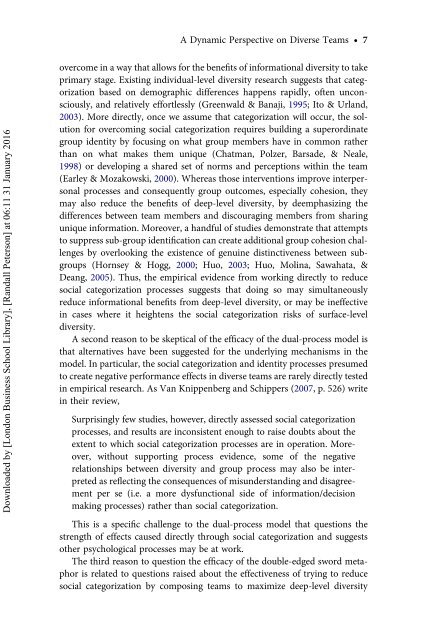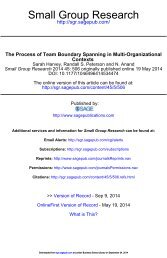A Dynamic Perspective on Diverse Teams: Moving From The Dual Process Model to A Dynamic Coordination-Based Model of Diverse Team Performance - Kannan Srikanth, Sarah Harvey & Randall Peterson
The existing literature on diverse teams suggests that diversity is both helpful to teams in making more information available and encouraging creativity and damaging to teams in reducing cohesion and information sharing. Thus the extant literature suggests that diversity within teams is a double-edged sword that leads to both positive and negative effects simultaneously.
The existing literature on diverse teams suggests that diversity is both helpful to teams in making more information available and encouraging creativity and
damaging to teams in reducing cohesion and information sharing. Thus the
extant literature suggests that diversity within teams is a double-edged sword
that leads to both positive and negative effects simultaneously.
You also want an ePaper? Increase the reach of your titles
YUMPU automatically turns print PDFs into web optimized ePapers that Google loves.
A <str<strong>on</strong>g>Dynamic</str<strong>on</strong>g> <str<strong>on</strong>g>Perspective</str<strong>on</strong>g> <strong>on</strong> <strong>Diverse</strong> <strong><strong>Team</strong>s</strong> † 7<br />
Downloaded by [L<strong>on</strong>d<strong>on</strong> Business School Library], [<strong>Randall</strong> Peters<strong>on</strong>] at 06:11 31 January 2016<br />
overcome in a way that allows for the benefits <strong>of</strong> informati<strong>on</strong>al diversity <strong>to</strong> take<br />
primary stage. Existing individual-level diversity research suggests that categorizati<strong>on</strong><br />
based <strong>on</strong> demographic differences happens rapidly, <strong>of</strong>ten unc<strong>on</strong>sciously,<br />
and relatively effortlessly (Greenwald & Banaji, 1995; I<strong>to</strong> & Urland,<br />
2003). More directly, <strong>on</strong>ce we assume that categorizati<strong>on</strong> will occur, the soluti<strong>on</strong><br />
for overcoming social categorizati<strong>on</strong> requires building a superordinate<br />
group identity by focusing <strong>on</strong> what group members have in comm<strong>on</strong> rather<br />
than <strong>on</strong> what makes them unique (Chatman, Polzer, Barsade, & Neale,<br />
1998) or developing a shared set <strong>of</strong> norms and percepti<strong>on</strong>s within the team<br />
(Earley & Mozakowski, 2000). Whereas those interventi<strong>on</strong>s improve interpers<strong>on</strong>al<br />
processes and c<strong>on</strong>sequently group outcomes, especially cohesi<strong>on</strong>, they<br />
may also reduce the benefits <strong>of</strong> deep-level diversity, by deemphasizing the<br />
differences between team members and discouraging members from sharing<br />
unique informati<strong>on</strong>. Moreover, a handful <strong>of</strong> studies dem<strong>on</strong>strate that attempts<br />
<strong>to</strong> suppress sub-group identificati<strong>on</strong> can create additi<strong>on</strong>al group cohesi<strong>on</strong> challenges<br />
by overlooking the existence <strong>of</strong> genuine distinctiveness between subgroups<br />
(Hornsey & Hogg, 2000; Huo, 2003; Huo, Molina, Sawahata, &<br />
Deang, 2005). Thus, the empirical evidence from working directly <strong>to</strong> reduce<br />
social categorizati<strong>on</strong> processes suggests that doing so may simultaneously<br />
reduce informati<strong>on</strong>al benefits from deep-level diversity, or may be ineffective<br />
in cases where it heightens the social categorizati<strong>on</strong> risks <strong>of</strong> surface-level<br />
diversity.<br />
A sec<strong>on</strong>d reas<strong>on</strong> <strong>to</strong> be skeptical <strong>of</strong> the efficacy <strong>of</strong> the dual-process model is<br />
that alternatives have been suggested for the underlying mechanisms in the<br />
model. In particular, the social categorizati<strong>on</strong> and identity processes presumed<br />
<strong>to</strong> create negative performance effects in diverse teams are rarely directly tested<br />
in empirical research. As Van Knippenberg and Schippers (2007, p. 526) write<br />
in their review,<br />
Surprisingly few studies, however, directly assessed social categorizati<strong>on</strong><br />
processes, and results are inc<strong>on</strong>sistent enough <strong>to</strong> raise doubts about the<br />
extent <strong>to</strong> which social categorizati<strong>on</strong> processes are in operati<strong>on</strong>. Moreover,<br />
without supporting process evidence, some <strong>of</strong> the negative<br />
relati<strong>on</strong>ships between diversity and group process may also be interpreted<br />
as reflecting the c<strong>on</strong>sequences <strong>of</strong> misunderstanding and disagreement<br />
per se (i.e. a more dysfuncti<strong>on</strong>al side <strong>of</strong> informati<strong>on</strong>/decisi<strong>on</strong><br />
making processes) rather than social categorizati<strong>on</strong>.<br />
This is a specific challenge <strong>to</strong> the dual-process model that questi<strong>on</strong>s the<br />
strength <strong>of</strong> effects caused directly through social categorizati<strong>on</strong> and suggests<br />
other psychological processes may be at work.<br />
<strong>The</strong> third reas<strong>on</strong> <strong>to</strong> questi<strong>on</strong> the efficacy <strong>of</strong> the double-edged sword metaphor<br />
is related <strong>to</strong> questi<strong>on</strong>s raised about the effectiveness <strong>of</strong> trying <strong>to</strong> reduce<br />
social categorizati<strong>on</strong> by composing teams <strong>to</strong> maximize deep-level diversity
















